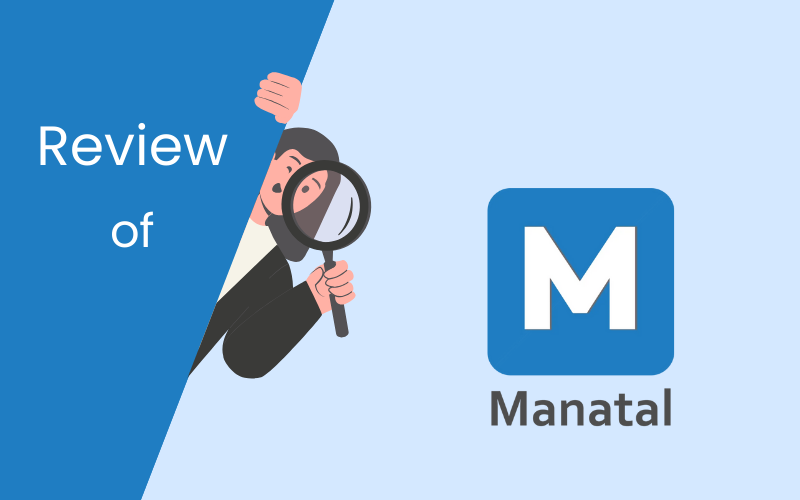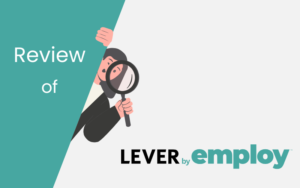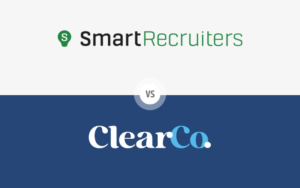In this detailed Manatal review, we take an in-depth look at one of the increasingly popular Applicant Tracking Systems (ATS) available today. Choosing the right ATS is crucial for streamlining your recruitment process, enhancing candidate experience, and improving overall hiring efficiency. To help you determine if Manatal is the best fit for your organization’s recruitment needs, this review thoroughly evaluates critical areas including usability, core features, candidate management, pricing, integrations, and much more. Read on to discover the strengths, limitations, and alternatives to Manatal, ensuring you make an informed decision for your recruiting success.
Table of Contents
User Interface and User Experience
In this comprehensive Manatal review, we critically assess the User Interface (UI) and User Experience (UX) of the Manatal Applicant Tracking System (ATS). For organizations evaluating ATS software, ease of use, design intuitiveness, and accessibility play crucial roles in determining whether a solution aligns with their recruitment needs. Here, we provide an in-depth look at how Manatal stacks up in these important areas.
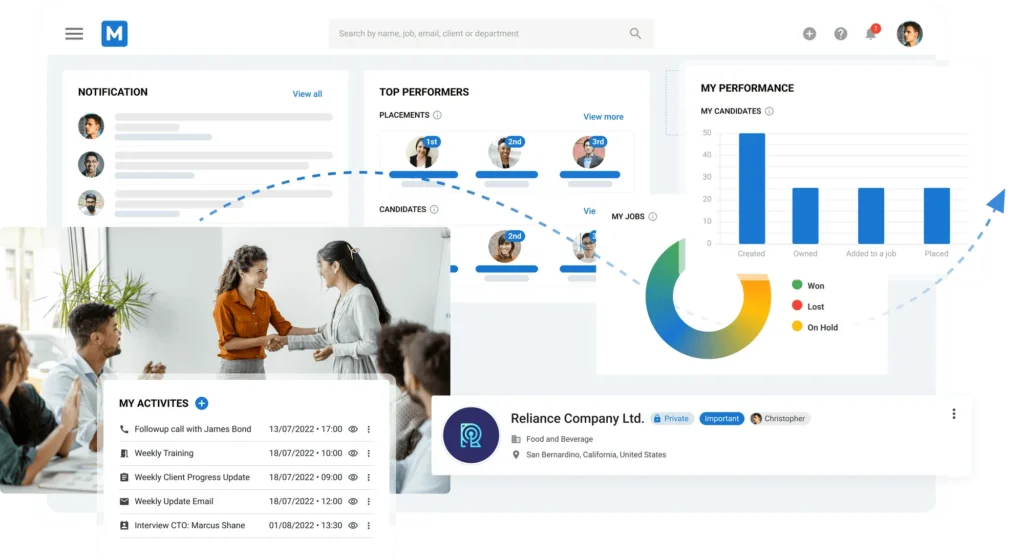
Intuitive Design
Manatal prides itself on offering an intuitive and user-friendly interface, designed specifically to minimize complexity for recruiters, hiring managers, and HR professionals. Upon logging in, users are greeted by a clean and logically structured dashboard, making critical features such as job postings, candidate searches, and pipeline management easily accessible with minimal navigation.
Recruiters report that tasks like screening resumes, updating candidate statuses, and initiating communications can typically be performed in just a few clicks. This simplicity significantly reduces the learning curve, allowing new users to quickly become productive within the system. For less tech-savvy users, this straightforward approach eliminates potential confusion, fostering confidence and improving overall productivity.
From a candidate perspective, the ease of the application process is equally impressive. Candidates interacting with Manatal-powered career sites experience straightforward application forms that avoid overwhelming complexity. Clear instructions, minimal steps, and user-friendly navigation help keep applicants engaged, decreasing dropout rates and ensuring that talented candidates complete their submissions.
However, while basic functions are impressively straightforward, some advanced features—such as custom pipeline modifications or reporting dashboards—may initially feel less intuitive. Users have noted that advanced settings sometimes require additional exploration or assistance from customer support before becoming comfortable. Therefore, companies that anticipate frequent adjustments to complex workflows might need additional onboarding time.
Customization and Personalization
Manatal offers a solid range of customization options, allowing recruiters to tailor their experience based on specific organizational needs. Users can easily adjust candidate pipeline stages, configure job templates, and personalize candidate profiles to reflect internal priorities and processes. This capability greatly enhances user engagement, as recruiters and hiring managers can access exactly what they need quickly and efficiently.
Moreover, Manatal supports personalized dashboards and allows recruiters to create customized job application workflows aligned with their recruiting strategy. Users appreciate the control this provides, enabling them to set up workflows that reflect their own terminology and recruitment processes, ultimately streamlining internal communication and efficiency.
Yet, compared to some competitors, Manatal’s depth of customization might feel somewhat restricted, especially for enterprise-level organizations or recruitment agencies that handle numerous complex workflows simultaneously. Some experienced users suggest that adding even more extensive customization capabilities would improve the system’s ability to scale within larger, more demanding recruitment environments.
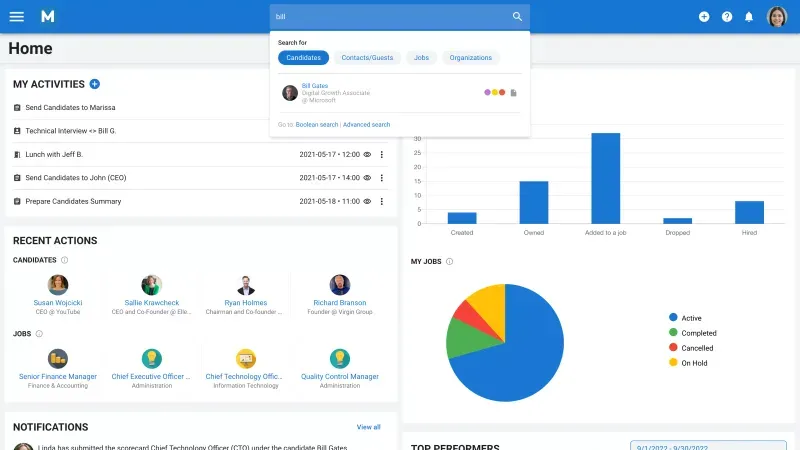
Mobile Responsiveness and Accessibility
A key highlight of Manatal’s UX is its exceptional mobile responsiveness. Understanding that recruiters increasingly need to manage hiring tasks remotely, Manatal has optimized its ATS to function seamlessly across smartphones, tablets, and desktops. Recruiters consistently report satisfaction with the platform’s performance on mobile devices, emphasizing how smoothly critical recruitment activities—like reviewing candidate profiles, scheduling interviews, and sending communications—can be performed on the go.
Candidates equally benefit from this mobile optimization, experiencing no loss of functionality when applying from mobile devices. The mobile-friendly application interface is fast, clean, and easy to use, significantly improving candidate experience and increasing the likelihood of applicants completing submissions.
While overall mobile responsiveness is highly rated, occasional users have mentioned minor challenges, such as delayed page loads or rare visual inconsistencies on older mobile devices. These issues, though infrequent, suggest there is still room for incremental improvement.
Engagement and Interaction
Manatal actively facilitates user engagement and interaction through intuitive communication features, real-time notifications, and collaborative tools integrated within the ATS. Recruiters can effortlessly communicate with candidates via email and messaging functions embedded directly into candidate profiles, creating a streamlined, centralized communication environment.
The platform also fosters internal collaboration among hiring teams through shared notes, comments, and candidate evaluation tools. These interaction features promote transparency and efficiency, enabling quicker decision-making and better-informed candidate assessments.
Nevertheless, certain users have pointed out occasional delays in notification alerts or messaging synchronization, which could cause temporary disruptions, particularly during high-volume hiring periods. While these occurrences are not frequent or significantly disruptive, they highlight opportunities for system refinement and reliability enhancement.
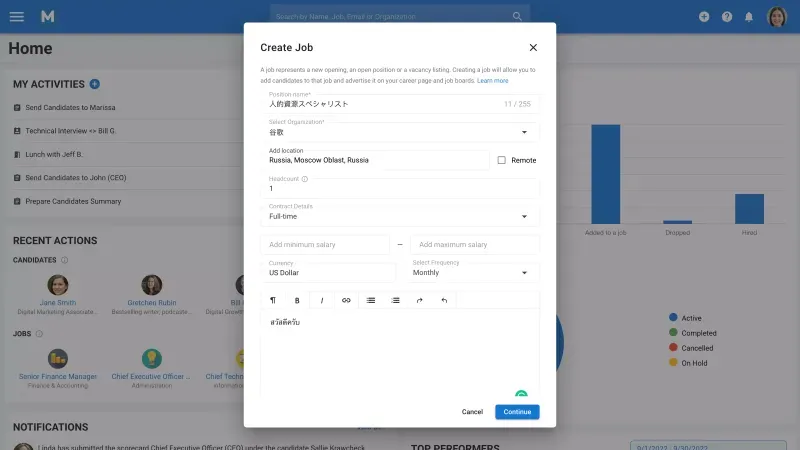
Pros and Cons
Understanding the strengths and potential drawbacks of Manatal’s user interface and user experience is essential before making an investment decision. Below, we summarize key advantages and disadvantages highlighted in this Manatal review.
Pros of Manatal User Interface and User Experience
- Clean and user-friendly design, significantly reducing onboarding time and allowing recruiters to focus more on hiring rather than navigating complexities.
- Strong mobile responsiveness, enabling efficient recruitment management from any device or location, enhancing flexibility and productivity.
- Straightforward candidate application process, reducing dropout rates and boosting applicant satisfaction.
- Effective internal collaboration tools, facilitating clear communication among recruitment teams and ensuring informed candidate evaluations.
Cons of Manatal User Interface and User Experience
- Limited advanced customization, which might restrict larger organizations or those with highly specialized recruitment workflows from fully tailoring the ATS to their complex needs.
- Occasional notification delays and messaging synchronization issues, creating temporary inconveniences for users.
- Initial usability challenges with advanced features, potentially requiring additional training or support for recruiters unfamiliar with more complex functionalities.
Conclusion
Overall, Manatal provides a highly intuitive, user-friendly ATS interface that excels in simplicity and mobile accessibility. Recruiters can effortlessly navigate the platform’s core features, reducing training requirements and enabling faster, more effective hiring processes. Candidates equally benefit from an uncomplicated and responsive application experience, making Manatal a strong choice for organizations aiming to attract and retain talent efficiently.
However, while these strengths make Manatal an appealing solution for many businesses, certain limitations must be considered. Organizations requiring extensive customization or frequent use of advanced features might find the system initially challenging or restrictive. Additionally, the rare but noticeable delays in notifications or messaging synchronization, though minor, may be inconvenient for fast-paced hiring teams.
Ultimately, Manatal is best suited for small to medium-sized organizations prioritizing ease of use, strong mobile functionality, and straightforward candidate engagement. Companies with very specialized requirements or complex recruitment workflows may need to assess if Manatal’s capabilities fully align with their specific needs. By carefully evaluating these strengths and weaknesses outlined in this Manatal review, organizations can confidently determine whether it represents the right ATS solution for their hiring strategy.
Core ATS Functions
In this detailed Manatal review, we examine the core applicant tracking system (ATS) functions offered by Manatal, specifically evaluating its job posting and distribution capabilities, resume parsing and screening tools, and candidate sourcing features. For recruiters and HR professionals, the effectiveness of these core functionalities significantly influences recruitment efficiency and hiring outcomes.

Job Posting and Distribution
One of the key strengths highlighted in our Manatal review is the platform’s robust job posting and distribution capabilities. Manatal simplifies the process of creating and distributing job listings through a straightforward, user-friendly interface. Recruiters can easily craft job posts using customizable templates, ensuring consistency across postings and significantly reducing time spent on administrative tasks.
Manatal supports automatic distribution of job advertisements across multiple job boards and social media channels, streamlining visibility and maximizing the reach of job postings. Popular job boards, including Indeed, LinkedIn, Glassdoor, and various industry-specific sites, integrate seamlessly, allowing recruiters to effortlessly reach targeted candidate pools. The ease of multi-channel job posting helps organizations attract diverse talent quickly, making it ideal for recruitment teams handling numerous openings simultaneously.
However, despite its strong multi-platform integrations, some users have reported occasional delays in postings going live on certain niche or regional job boards, suggesting the platform could benefit from further optimization in specific markets.
Resume Parsing and Screening
Efficient resume parsing and candidate screening are crucial to the functionality of any ATS. Manatal’s resume parsing capabilities stand out as highly effective and reliable. When candidates apply, the system automatically extracts key data points from resumes—including work experience, education, skills, and contact details—and converts them into structured, searchable candidate profiles. This dramatically reduces manual data entry, minimizing errors and speeding up the initial screening phase.
In addition to robust parsing capabilities, Manatal offers automated resume screening features. Recruiters can establish specific qualification criteria, allowing the ATS to automatically filter applicants based on experience, education, skills, or other defined parameters. This feature helps recruiters quickly narrow down candidate pools to the most relevant applicants, enhancing recruitment efficiency significantly.
Nevertheless, advanced parsing accuracy may occasionally vary depending on the format or layout of resumes uploaded. For best results, candidates should submit standard resume formats such as PDF or Word documents, as some complex layouts or designs can lead to minor parsing inaccuracies.
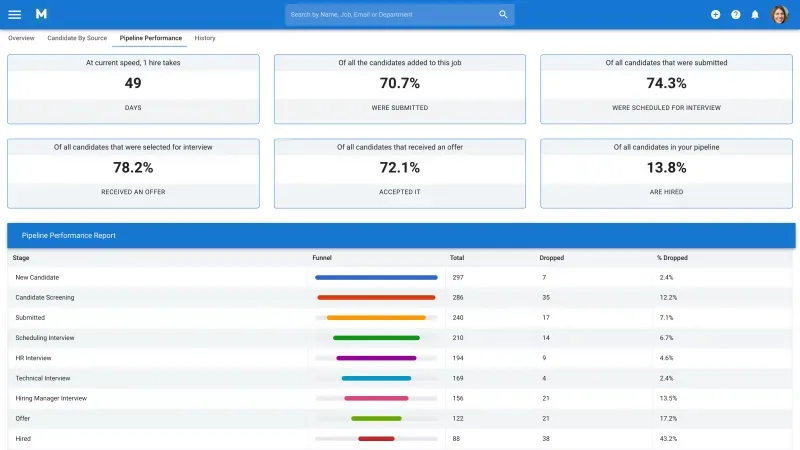
Candidate Sourcing Tools
Another essential element examined in this Manatal review is the strength of its candidate sourcing capabilities. Manatal provides powerful sourcing tools designed to help recruiters proactively identify and engage with potential candidates outside of incoming applications. Recruiters can leverage built-in sourcing integrations with LinkedIn, GitHub, and other professional networks, effortlessly pulling candidate information directly into the ATS.
Additionally, Manatal enables recruiters to build detailed candidate databases, tag potential candidates by skills, location, or job roles, and perform targeted searches within existing talent pools. The platform’s intuitive search filters help recruitment teams quickly identify passive candidates who might be ideal fits for current or future openings, saving considerable time and effort in sourcing activities.
However, some recruiters find Manatal’s sourcing tools somewhat limited when compared to dedicated sourcing software, particularly in advanced features like AI-driven recommendations or passive candidate outreach automation. While Manatal covers most sourcing essentials effectively, organizations with sophisticated sourcing requirements might require supplemental tools to maximize sourcing efficiency fully.
Pros and Cons
When evaluating Manatal’s core ATS functionalities, recruiters and HR teams should consider both the strengths and potential limitations identified in this Manatal review.
Pros of Manatal Core ATS Functions
- Efficient job posting and automatic distribution to major job boards and social media platforms, significantly expanding job visibility.
- Reliable resume parsing and automated candidate screening, dramatically reducing manual workload and improving accuracy in candidate assessments.
- Intuitive candidate sourcing capabilities, enabling proactive talent discovery and streamlined database searches.
- Easy-to-use interface, simplifying tasks related to job posting, candidate filtering, and talent sourcing.
Cons of Manatal Core ATS Functions
- Occasional delays in job postings appearing on niche or regional job boards, impacting timely visibility in specific markets.
- Minor inaccuracies in resume parsing with complex or non-standard resume formats.
- Limited advanced candidate sourcing features compared to dedicated sourcing platforms, particularly affecting recruiters who heavily rely on passive candidate searches or advanced sourcing automation.
Conclusion
In conclusion, Manatal’s core ATS functions perform exceptionally well in simplifying and streamlining the recruitment process, particularly in job posting automation, resume parsing accuracy, and essential candidate sourcing. Recruiters benefit significantly from reduced administrative tasks and greater accuracy in candidate screening, improving overall hiring efficiency.
However, recruiters and HR teams should be aware of certain limitations, including occasional delays in job distribution on specialized job boards, minor resume parsing inaccuracies with non-standard formats, and somewhat limited advanced sourcing capabilities. Organizations with more intricate sourcing needs or highly specific job board requirements might need to supplement Manatal’s core functions with additional specialized tools.
Ultimately, Manatal is ideally suited for small to medium-sized businesses or recruitment teams seeking a straightforward, reliable, and efficient ATS solution. Companies with more advanced sourcing or specialized posting needs should carefully evaluate these limitations to ensure Manatal fully aligns with their strategic recruitment objectives.
Applicant Management
In this detailed Manatal review, we analyze the applicant management capabilities provided by Manatal’s Applicant Tracking System (ATS). Effective applicant management is critical for recruiters and hiring teams aiming to streamline their recruitment process, enhance candidate communication, and efficiently coordinate interview schedules. Here, we examine Manatal’s features including candidate pipeline visualization, communication tools, and interview scheduling capabilities.
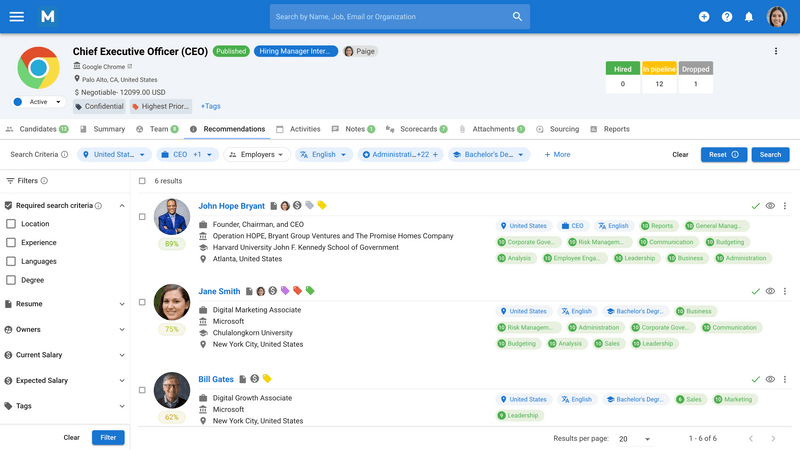
Candidate Pipeline Visualization
Manatal provides recruiters with a highly intuitive candidate pipeline visualization tool designed to simplify tracking applicants through various recruitment stages. This visual pipeline offers clear, real-time visibility of each candidate’s current status, whether it’s initial application review, phone screening, interviewing, or offer stages. Recruiters can easily drag-and-drop candidates from one stage to another, enabling smooth management of candidate progress and ensuring that no candidate falls through the cracks.
Additionally, recruiters can customize pipeline stages according to their specific recruitment workflow. This adaptability ensures alignment with internal processes, significantly enhancing efficiency and reducing confusion across hiring teams. Users consistently highlight this visual pipeline as one of Manatal’s strongest features, facilitating clear oversight and providing immediate insights into recruitment progress.
Despite its overall ease of use, some recruiters mention that the visual pipeline can become slightly cluttered or challenging to navigate when managing large candidate pools. Thus, organizations conducting high-volume hiring might need to carefully structure or segment pipelines to maintain clarity and usability.
Communication Tools (Email, SMS, etc.)
Communication plays a pivotal role in applicant management, and in this Manatal review, it’s clear the platform excels in providing integrated communication capabilities. Recruiters can communicate directly with candidates from within the ATS via email and SMS, allowing for efficient and timely interactions. Manatal stores these communications within candidate profiles, providing a centralized record that helps recruiters maintain clear, organized, and consistent candidate interactions.
Manatal also supports automated email templates for common recruitment communications, such as interview scheduling confirmations, rejections, and updates regarding next steps. This automation saves significant time and ensures candidates remain informed throughout the recruitment process, enhancing candidate experience and maintaining engagement levels.
One limitation noted by users is occasional delays or inconsistencies with SMS messaging functionality in certain regions. Organizations heavily reliant on SMS-based communications should test and verify reliability in their specific geographic area.

Interview Scheduling
Efficient interview scheduling is another essential component of successful applicant management, and Manatal significantly simplifies this aspect of recruitment. Within Manatal’s ATS, recruiters can easily coordinate and schedule interviews using integrated calendar functionalities that sync seamlessly with external calendars such as Google Calendar, Outlook, and other popular scheduling tools.
Interview invitations can be sent directly from Manatal to candidates, allowing them to select from available time slots. Recruiters can then manage and track interview appointments directly within the candidate pipeline, receiving automated reminders and notifications to minimize scheduling conflicts. These capabilities greatly reduce the administrative burden traditionally associated with interview coordination, allowing recruitment teams to focus more on candidate evaluation and less on logistical complexities.
However, users have mentioned occasional syncing delays or calendar integration glitches, particularly with certain third-party calendar services. While rare, these issues underscore the need for periodic verification of calendar synchronization to ensure accuracy in scheduling.
Pros and Cons
To fully understand Manatal’s strengths and weaknesses in applicant management, consider the key advantages and limitations identified in this Manatal review.
Pros of Manatal Applicant Management
- Intuitive visual pipeline, allowing easy tracking and management of candidate statuses through customizable stages.
- Integrated communication tools, including email and SMS, facilitating clear and timely candidate interactions.
- Centralized candidate communication records, enabling organized tracking of conversations and reducing communication errors.
- Efficient interview scheduling integration, significantly minimizing scheduling burdens and improving recruiter productivity.
Cons of Manatal Applicant Management
- Potential clutter in pipeline visualization when handling large candidate volumes, potentially impacting usability.
- Occasional inconsistencies with SMS messaging functionality in certain geographical locations.
- Rare synchronization issues with third-party calendars, which could temporarily disrupt interview scheduling efficiency.
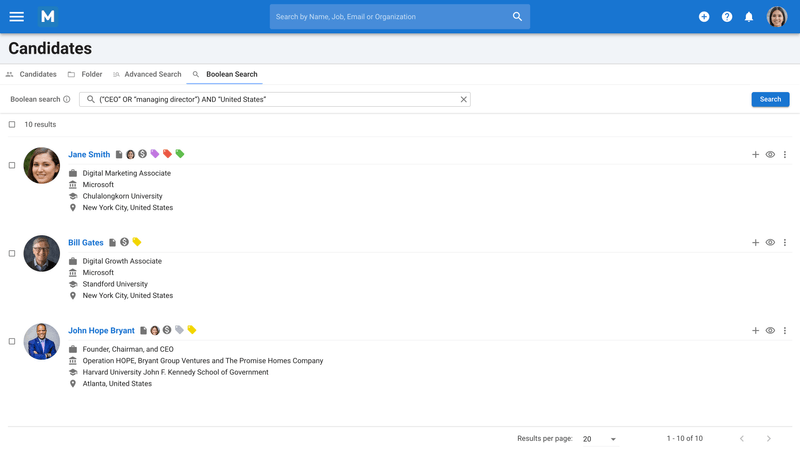
Conclusion
In summary, Manatal provides robust and efficient applicant management features that effectively streamline candidate tracking, communication, and interview scheduling. Its visual candidate pipeline and integrated communication tools significantly enhance recruiter efficiency and improve candidate experiences by providing clear, timely, and organized interactions throughout the hiring process.
Nevertheless, organizations should carefully consider minor limitations such as potential clutter in pipeline visualization during high-volume hiring, occasional SMS reliability issues in certain regions, and rare calendar synchronization glitches. Teams heavily reliant on these functions should test thoroughly to ensure Manatal aligns with their specific needs and workflows.
Ultimately, Manatal’s applicant management features are particularly well-suited to small and medium-sized organizations seeking an intuitive, integrated, and straightforward recruitment solution. High-volume or complex recruitment teams should verify these functions meet their unique operational demands to maximize Manatal’s value for their hiring processes.
Recruitment Marketing
In this thorough Manatal review, we delve into the recruitment marketing functionalities offered by Manatal’s Applicant Tracking System (ATS). Recruitment marketing is critical for organizations aiming to attract top talent by showcasing their employer brand, promoting job openings effectively, and leveraging their employees’ networks. Here, we evaluate Manatal’s career site builder, social media integration, and employee referral program capabilities.

Career Site Builder
A key component of successful recruitment marketing is a compelling and professional career site, and Manatal makes this easy with its built-in career site builder. The platform provides straightforward tools for creating branded career pages that reflect an organization’s unique identity, culture, and employer value proposition. Recruiters can easily customize their career sites, adjusting design elements such as colors, logos, images, and layouts, all without requiring technical skills or coding knowledge.
Manatal’s career site builder also emphasizes mobile responsiveness, ensuring that career pages display effectively on all devices. This mobile optimization is crucial, as many candidates now search and apply for jobs using smartphones or tablets. Additionally, Manatal provides built-in SEO (Search Engine Optimization) capabilities, helping job listings gain better visibility on search engines and attracting more qualified applicants organically.
However, some users note that Manatal’s career site customization features, while user-friendly, could benefit from greater flexibility or advanced design options. Larger organizations with sophisticated branding requirements might find these tools somewhat limited compared to dedicated recruitment marketing platforms.
Social Media Integration
In today’s recruitment landscape, social media integration is essential for extending the reach of job postings and engaging potential candidates where they spend much of their time. Manatal excels in this area, offering robust integration with major social media platforms such as LinkedIn, Facebook, Twitter, and more. Recruiters can seamlessly share job openings directly from the ATS onto these platforms, maximizing visibility and improving the likelihood of attracting passive candidates.
Social sharing capabilities within Manatal simplify the creation of social media posts, allowing recruiters to publish consistently branded messages quickly and easily. Furthermore, the platform tracks engagement data, providing valuable insights into the performance of job posts across different social channels. This feature helps recruiters fine-tune their social recruitment strategies over time.
A minor drawback highlighted in this Manatal review is that advanced analytics on social media campaign effectiveness could be expanded. Organizations heavily reliant on data-driven social recruitment strategies might require supplemental analytical tools for more granular insights.
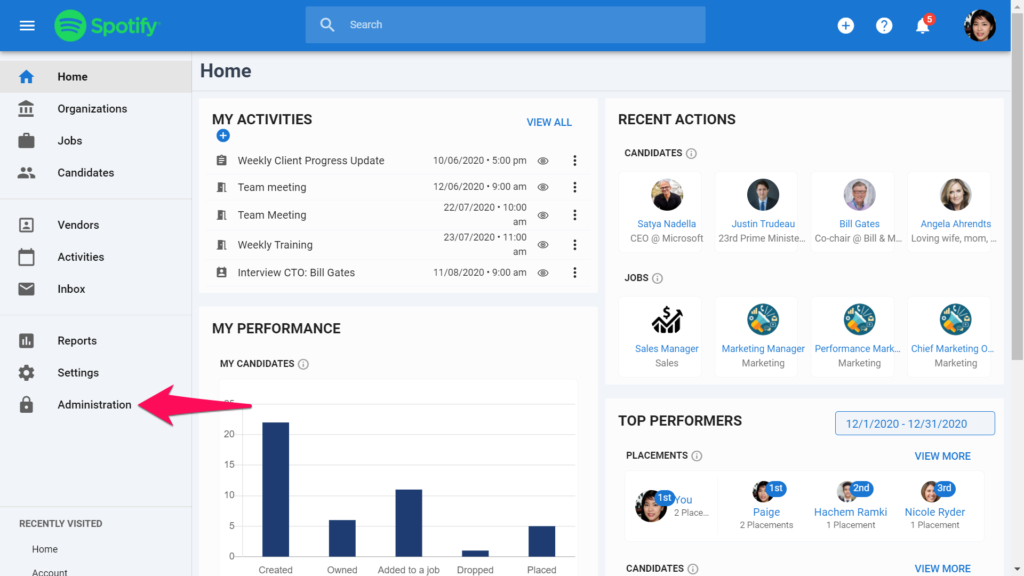
Employee Referral Programs
Employee referrals are often among the most effective sources of high-quality candidates, and Manatal facilitates referral management through its integrated referral program feature. The platform enables organizations to easily set up and manage referral campaigns, allowing current employees to effortlessly submit referrals through a user-friendly portal. Manatal efficiently tracks referrals, linking them directly to the referring employees and maintaining transparent records for easy management.
Recruiters can also automate communications regarding referral statuses, keeping employees informed and motivated to continue participating in referral programs. This automation streamlines the process significantly, reducing the administrative burden while enhancing engagement and participation levels.
One potential limitation is the lack of extensive gamification or incentive management features, which some advanced standalone referral platforms offer. Organizations wishing to implement complex referral rewards or highly interactive referral campaigns might find Manatal’s referral capabilities slightly limited.
Pros and Cons
Considering Manatal’s strengths and limitations in recruitment marketing, the following points summarize the key insights from this Manatal review.
Pros of Manatal Recruitment Marketing
- Easy-to-use career site builder enabling rapid creation of mobile-responsive, SEO-friendly career pages without technical expertise.
- Strong social media integration facilitating broad job distribution and enhanced candidate reach.
- Integrated employee referral management, streamlining referrals and providing effective tracking and automated communications.
- Clear and intuitive user experience, allowing quick adoption and easy management of recruitment marketing activities.
Cons of Manatal Recruitment Marketing
- Limited advanced customization options in the career site builder, potentially constraining large organizations with detailed branding requirements.
- Basic social media analytics, lacking depth for organizations relying on highly detailed, data-driven recruitment marketing strategies.
- Minimal gamification or advanced incentive management within employee referral programs, which might restrict creative or complex referral strategies.
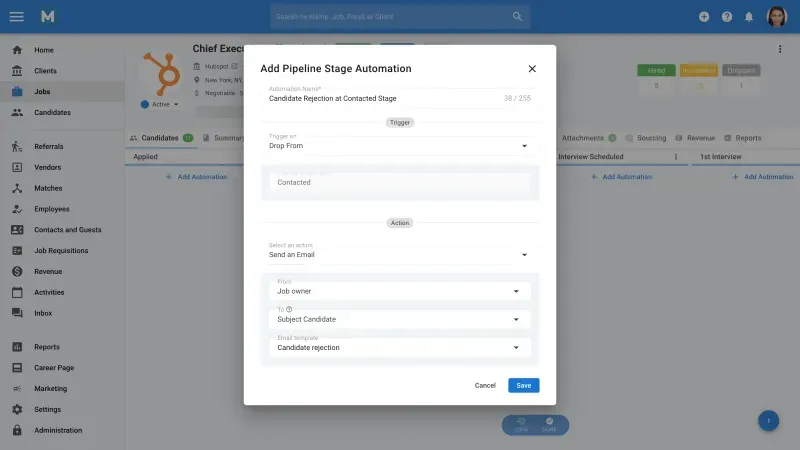
Conclusion
Overall, Manatal’s recruitment marketing features significantly streamline the process of attracting and engaging quality candidates. Its intuitive career site builder, robust social media integration, and straightforward employee referral management make it a strong choice for companies seeking an efficient recruitment marketing solution.
However, organizations with highly sophisticated recruitment marketing needs—such as extensive career site customization, advanced social media analytics, or complex employee referral programs—should consider these limitations carefully. Supplementary tools might be required for larger companies or those with more intricate recruitment marketing strategies.
Ultimately, Manatal is an excellent match for small to medium-sized organizations or teams prioritizing simplicity, ease of use, and effective job visibility in their recruitment marketing efforts. Companies with more complex recruitment marketing objectives should verify that Manatal fully aligns with their requirements before committing to the platform.
Collaboration Tools
In this comprehensive Manatal review, we closely examine the collaboration tools integrated into Manatal’s Applicant Tracking System (ATS). Effective team collaboration is vital for recruitment success, enabling hiring teams to share candidate evaluations, streamline internal communication, and facilitate transparent decision-making. Below, we assess how Manatal performs regarding team feedback, evaluation tools, and internal messaging functionalities.
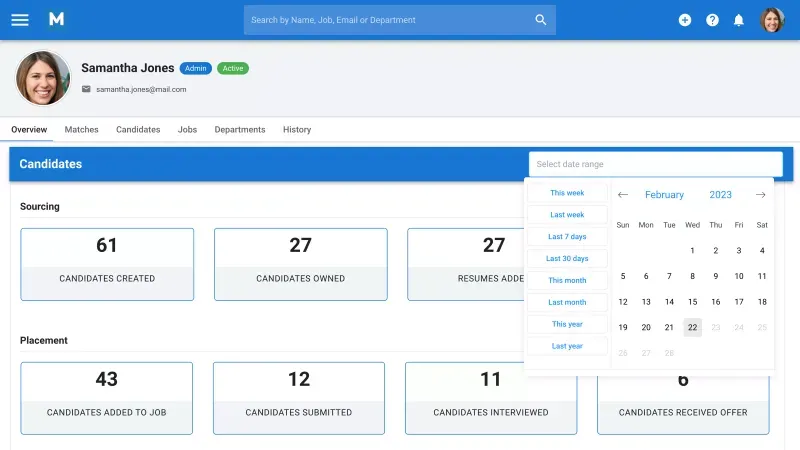
Team Feedback and Evaluation
Manatal provides recruitment teams with intuitive and structured feedback and evaluation features that simplify the collaborative assessment of candidates. Recruiters and hiring managers can effortlessly leave notes, ratings, and evaluations directly within candidate profiles, maintaining clear and centralized records accessible to all team members involved in the recruitment process.
Recruiters particularly appreciate Manatal’s ability to customize evaluation criteria according to specific job roles or organizational preferences. This allows teams to standardize the candidate assessment process, ensuring consistency and fairness in hiring decisions. Moreover, real-time visibility into each team member’s feedback promotes collaborative discussions, accelerating consensus and decision-making.
Despite these strengths, some users suggest that Manatal could enhance its feedback system by adding advanced scoring mechanisms or comparative evaluation tools, enabling more nuanced assessments, especially during high-volume hiring processes where quick comparisons between multiple candidates become necessary.
Internal Messaging and Notes
Effective internal communication is central to any successful recruitment strategy, and in this Manatal review, the internal messaging and note-taking capabilities stand out as practical and user-friendly. Manatal allows recruiters, hiring managers, and HR staff to communicate seamlessly within the platform through built-in messaging functionalities tied directly to candidate profiles. This significantly streamlines information exchange and reduces the need to rely on external communication tools or fragmented email chains.
The platform also supports internal notes and comment threads, which can be attached directly to individual candidate records. This feature ensures that essential context and communications remain organized and easily accessible, providing clarity and efficiency during the evaluation process. Recruiters regularly highlight this centralized approach as a valuable benefit, simplifying candidate management and minimizing miscommunications within teams.
However, some users have noted that real-time messaging could be further improved by adding direct chat features or notifications, especially useful for teams requiring rapid responses in fast-paced hiring environments. Currently, Manatal’s messaging primarily functions asynchronously, which may not fully satisfy teams needing immediate interaction.
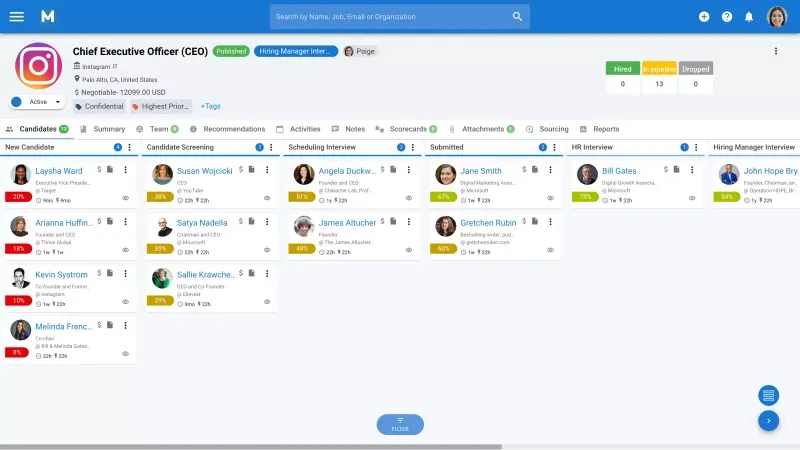
Pros and Cons
To fully understand the advantages and potential limitations of Manatal’s collaboration tools, consider these key insights from our Manatal review:
Pros of Manatal Collaboration Tools
- Structured candidate evaluation system, facilitating consistent, transparent, and organized team feedback.
- Centralized internal messaging and note-taking, significantly enhancing internal communication and reducing the risk of miscommunication.
- Customizable evaluation criteria, enabling teams to tailor feedback processes to specific hiring needs.
- User-friendly interface, ensuring quick adoption among diverse hiring teams.
Cons of Manatal Collaboration Tools
- Limited advanced evaluation tools, lacking features such as comparative candidate scoring or advanced rating metrics, potentially limiting detailed candidate comparisons.
- Absence of real-time chat or instant messaging capabilities, which might limit rapid internal communications, particularly in dynamic recruitment environments.
Conclusion
In summary, Manatal delivers robust and user-friendly collaboration tools that greatly enhance team communication and streamline candidate evaluations. Its structured feedback system, customizable evaluation options, and centralized internal messaging make Manatal particularly valuable for recruitment teams seeking effective and organized collaboration.
However, organizations that require highly detailed comparative assessments, advanced evaluation scoring, or immediate real-time internal communication should carefully evaluate Manatal’s capabilities against their specific collaboration requirements. Companies operating in rapid hiring contexts or handling large volumes of candidates may find some of Manatal’s collaborative functionalities slightly limited.
Ultimately, Manatal is well-suited to small and medium-sized businesses or recruitment teams emphasizing clarity, organization, and simplicity in their collaborative hiring processes. Teams with more complex collaborative needs should assess if Manatal fully meets their operational goals or consider supplemental tools for enhanced collaboration.
Onboarding Integration
In this detailed Manatal review, we closely examine the onboarding integration capabilities provided by Manatal’s Applicant Tracking System (ATS). Effective onboarding integration helps organizations seamlessly transition new hires from recruitment to employment, simplifying tasks such as offer letter management and paperwork automation. Below, we evaluate how well Manatal performs in streamlining these critical onboarding processes.
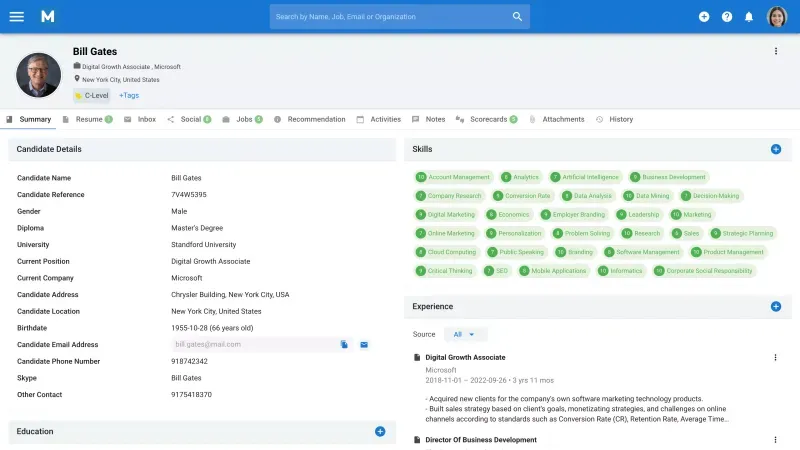
Offer Letter Management
One of the standout onboarding features of Manatal is its efficient offer letter management system. Manatal simplifies the creation, distribution, and tracking of offer letters directly within the ATS. Recruiters can quickly generate personalized offer letters using customizable templates, which helps ensure consistency, accuracy, and compliance with internal company standards.
Once an offer letter is prepared, Manatal enables recruiters to send these letters directly to candidates through the system, significantly streamlining the communication process. Additionally, recruiters can monitor candidate responses in real-time, tracking acceptance status directly within candidate profiles. This centralized approach minimizes errors, enhances transparency, and accelerates the hiring process.
While the offer letter management process is generally straightforward, some users have expressed a desire for enhanced electronic signature integrations. Currently, organizations requiring advanced digital signature workflows might need to integrate external e-signature platforms to fully streamline the offer acceptance process.
New Hire Paperwork Automation
Efficient paperwork management is another critical aspect of onboarding integration, and in this Manatal review, the platform performs well in automating these administrative tasks. Manatal allows organizations to automate the collection and management of essential new hire documentation, including contracts, compliance forms, and tax paperwork. By digitizing these traditionally manual processes, Manatal significantly reduces administrative burdens, enabling HR teams to focus on more strategic onboarding activities.
Recruiters appreciate the system’s automated reminders and notifications, which prompt new hires to complete required documents in a timely manner. Manatal’s centralized document storage also ensures secure, organized, and easily accessible records, aiding compliance efforts and simplifying audits or reviews.
However, organizations with highly complex onboarding requirements or multiple regulatory obligations across jurisdictions might find Manatal’s paperwork automation capabilities somewhat basic. Advanced automation features, such as conditional workflows or region-specific document customization, may require integration with dedicated HR or onboarding software.

Pros and Cons
To effectively evaluate Manatal’s onboarding integration capabilities, organizations should consider both the benefits and potential limitations identified in this Manatal review:
Pros of Manatal Onboarding Integration
- Streamlined offer letter management, enabling quick, consistent, and compliant creation and distribution of employment offers.
- Effective paperwork automation, significantly reducing administrative workload related to onboarding documentation.
- Centralized onboarding records, providing organized and secure access to new hire documents and compliance paperwork.
- User-friendly onboarding tools, facilitating easy adoption and use by recruitment and HR teams.
Cons of Manatal Onboarding Integration
- Limited built-in electronic signature capabilities, potentially requiring integration with external digital signature solutions for comprehensive functionality.
- Basic automation features, which may fall short for organizations with highly specialized onboarding workflows or regulatory complexity.
Conclusion
Overall, Manatal provides reliable onboarding integration features that effectively streamline critical administrative tasks involved in transitioning candidates into new hires. Its strengths in offer letter management and paperwork automation help HR teams reduce manual processes, accelerate onboarding timelines, and ensure compliance.
However, organizations requiring more complex onboarding automation, advanced digital signature processes, or highly customized document workflows might need to consider additional integrations with specialized onboarding tools. Manatal’s onboarding integration features are particularly well-suited for small to medium-sized organizations that value simplicity and efficiency in their onboarding processes.
Companies with more extensive onboarding complexities or regulatory demands should carefully evaluate whether Manatal meets their complete requirements or if supplemental software solutions would better enhance their onboarding efficiency and compliance efforts.
Reporting and Analytics
In this detailed Manatal review, we examine the reporting and analytics capabilities provided by Manatal’s Applicant Tracking System (ATS). Effective reporting and analytics are crucial for recruitment teams aiming to track performance, optimize hiring strategies, and demonstrate recruitment effectiveness. Below, we explore Manatal’s strengths and limitations regarding recruitment metrics, KPI tracking, and custom report generation.
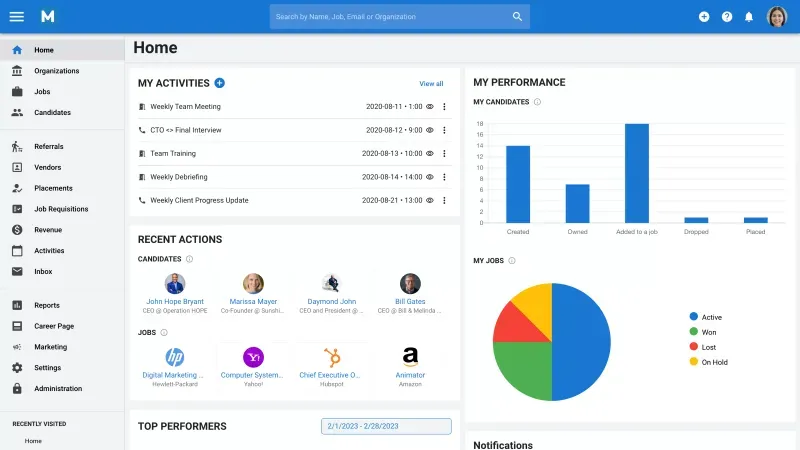
Recruitment Metrics and KPIs
One of Manatal’s notable strengths is its clear and comprehensive recruitment metrics dashboard, offering recruiters immediate insights into critical recruitment data. The platform provides key performance indicators (KPIs) such as time-to-hire, source effectiveness, candidate conversion rates, and pipeline stage metrics. These built-in analytics empower recruitment teams to quickly understand hiring trends, identify bottlenecks, and make data-driven decisions to improve their overall recruitment processes.
The analytics dashboard is user-friendly and visually intuitive, making it accessible even to team members with limited technical or analytical backgrounds. Manatal’s visual charts and graphs simplify data interpretation, enabling recruiters and hiring managers to rapidly assess progress and address issues proactively. The immediacy and clarity of these insights support strategic decision-making and improve recruitment efficiency significantly.
However, while Manatal covers essential recruitment KPIs comprehensively, organizations with complex analytics requirements or highly specialized metrics might find its standard metrics somewhat limited. For instance, deeper analytics on candidate diversity, detailed sourcing ROI analysis, or predictive analytics are less extensive compared to dedicated reporting tools or larger ATS providers.
Custom Report Generation
In addition to built-in reporting features, Manatal offers robust custom report generation capabilities, allowing recruitment teams to create tailored reports aligned specifically with their internal goals or stakeholder requirements. Users can easily select specific data points, filter candidate information by job role, recruiter, hiring stage, or time frame, and export detailed reports in various formats such as CSV or Excel.
This customization significantly enhances the flexibility of Manatal’s reporting features, enabling teams to drill down into specific recruitment details, create targeted analysis, and present findings clearly to management or stakeholders. Recruiters appreciate the ability to save and reuse customized reporting templates, streamlining recurring analysis and minimizing repetitive tasks.
One limitation, however, highlighted by some users is that advanced reporting features—such as automated scheduled reports or highly customized visualizations—could be further enhanced. Organizations frequently needing complex visual reports or scheduled recurring analytics might find Manatal’s current capabilities slightly restrictive, potentially requiring manual interventions or integration with external business intelligence software.
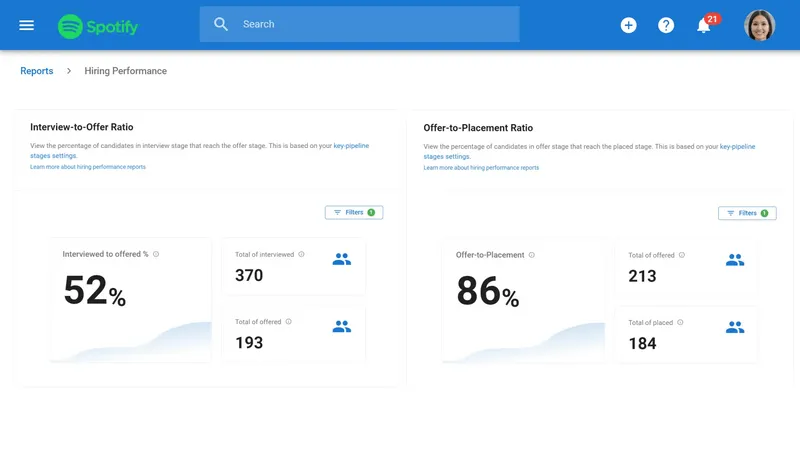
Pros and Cons
To effectively evaluate Manatal’s reporting and analytics features, recruitment teams should consider both the benefits and potential limitations outlined in this Manatal review:
Pros of Manatal Reporting and Analytics
- Comprehensive built-in metrics, providing immediate visibility into critical recruitment KPIs such as time-to-hire and candidate source effectiveness.
- User-friendly analytics dashboard, enabling quick and intuitive interpretation of recruitment performance data.
- Robust custom report generation capabilities, allowing tailored reporting aligned with specific organizational goals and needs.
- Easy report export and template saving, streamlining repetitive reporting tasks and facilitating stakeholder communication.
Cons of Manatal Reporting and Analytics
- Limited advanced analytics features, such as deep diversity reporting, predictive hiring analytics, or highly detailed ROI calculations.
- No automated scheduling of custom reports, potentially increasing manual workload for recurring reporting needs.
- Basic visual customization options, restricting detailed visualizations or advanced graphical presentations of data.
Conclusion
Overall, Manatal provides strong and accessible reporting and analytics capabilities suited to most recruitment teams’ fundamental needs. Its user-friendly dashboard, clear metrics presentation, and easy-to-use custom reporting tools empower recruitment teams to track performance effectively, enhance decision-making, and streamline stakeholder communication.
However, organizations requiring sophisticated analytics, highly specialized reporting, or automated scheduling should carefully evaluate these limitations. Larger recruitment teams or those operating in data-intensive environments might benefit from integrating additional business intelligence tools alongside Manatal to fully meet their advanced reporting and analytics demands.
Ultimately, Manatal is well-suited for small to medium-sized organizations or recruitment teams seeking straightforward, actionable insights without complex configurations. Companies with more advanced analytics expectations should assess whether Manatal fully aligns with their comprehensive reporting requirements or whether supplementary analytics software may be necessary.
Compliance and Data Security
In this comprehensive Manatal review, we explore the compliance and data security measures provided by Manatal’s Applicant Tracking System (ATS). Maintaining compliance with data protection regulations and ensuring robust data security are critical for organizations managing sensitive candidate information. Below, we analyze how effectively Manatal handles GDPR, CCPA, and other regulatory compliance standards, as well as its data encryption and protection strategies.
GDPR, CCPA, and Other Regulatory Compliance
Manatal places a strong emphasis on helping organizations maintain compliance with key international data protection regulations, including GDPR (General Data Protection Regulation) and CCPA (California Consumer Privacy Act). The platform provides built-in compliance features such as candidate consent management, data access controls, and automated data retention policies, significantly simplifying the task of remaining compliant with regulatory requirements.
Within Manatal, recruiters can easily track candidate consent statuses and preferences directly in the candidate profiles, ensuring clear documentation and transparency. The system also supports automated reminders and notifications related to consent expirations and data retention policies, helping HR teams proactively manage compliance and reduce the risk of regulatory violations.
Additionally, Manatal’s data deletion features support compliance efforts, allowing recruiters to efficiently remove candidate information upon request, meeting GDPR’s “right to be forgotten” and similar requirements under CCPA. This streamlined approach greatly reduces administrative workload while ensuring regulatory compliance.
However, some users mention that while Manatal provides solid compliance foundations, organizations operating across multiple jurisdictions with varying local regulations might need additional customization or manual oversight. Advanced compliance management—such as multi-region policy enforcement or complex auditing capabilities—is somewhat limited compared to specialized compliance solutions.
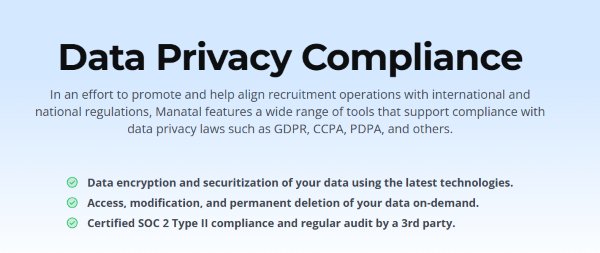
Data Encryption and Protection Measures
Ensuring the security and protection of candidate data is crucial for any ATS solution, and in this Manatal review, the platform demonstrates robust data encryption and security measures. Manatal employs industry-standard encryption protocols (SSL/TLS) to protect data both in transit and at rest. This ensures that candidate information remains secure from unauthorized access or potential breaches.
Manatal also maintains secure data hosting facilities compliant with internationally recognized standards, including ISO 27001, which further enhances user confidence in data security. Access to sensitive candidate information within the system is controlled through role-based permissions, allowing organizations to restrict data visibility according to individual roles or responsibilities. These permissions help prevent unauthorized data access and significantly reduce internal security risks.
Moreover, the platform provides regular data backups and recovery capabilities, ensuring that critical candidate data remains protected against loss or system failures. Recruiters and HR teams consistently cite these comprehensive security features as a major advantage of Manatal, enhancing their trust and satisfaction in using the system.
Nevertheless, some larger organizations may find Manatal’s customization options for security protocols somewhat limited. Advanced security configurations, such as multi-factor authentication (MFA) or more granular data access controls, are less extensive than some dedicated enterprise-level ATS platforms or standalone security tools.
Pros and Cons
To effectively assess Manatal’s compliance and data security features, organizations should consider the following pros and cons identified in this Manatal review:
Pros of Manatal Compliance and Data Security
- Robust built-in GDPR and CCPA compliance features, simplifying regulatory adherence for recruiters and HR professionals.
- Strong data encryption standards, protecting sensitive candidate data both in transit and at rest.
- Secure data hosting and regular backups, ensuring high levels of data protection and reliable disaster recovery options.
- Role-based access controls, minimizing internal security risks by restricting sensitive data access according to user roles.
Cons of Manatal Compliance and Data Security
- Limited advanced compliance customization, potentially requiring additional manual oversight for multi-region or complex regulatory environments.
- Basic security configuration options, such as the absence of multi-factor authentication or highly granular access controls, which may limit enterprise-level security requirements.
Conclusion
Overall, Manatal provides strong compliance and data security features suited to most small and medium-sized organizations. Its robust GDPR and CCPA compliance tools, combined with effective data encryption and secure hosting practices, help organizations manage candidate data responsibly and securely, significantly reducing regulatory risks and ensuring data protection.
However, enterprises or organizations with extensive, multi-jurisdictional compliance needs, or those requiring highly advanced security measures, might need supplementary solutions or additional customization beyond Manatal’s standard features. Organizations should carefully evaluate whether Manatal fully addresses their specific compliance and security requirements, especially if operating within particularly stringent or complex regulatory environments.
Ultimately, Manatal offers excellent value for recruitment teams seeking straightforward, reliable compliance and data security measures. Organizations with more advanced needs should assess if Manatal aligns fully with their expectations or if additional specialized security or compliance tools are necessary.
Integration and Compatibility
In this detailed Manatal review, we focus on the integration and compatibility capabilities provided by Manatal’s Applicant Tracking System (ATS). Seamless integration with existing HR systems and third-party recruitment tools is essential for creating efficient workflows, reducing manual tasks, and improving overall recruitment productivity. Here, we evaluate Manatal’s strengths and limitations in terms of HRIS/HCM system integration and third-party recruitment tool compatibility.
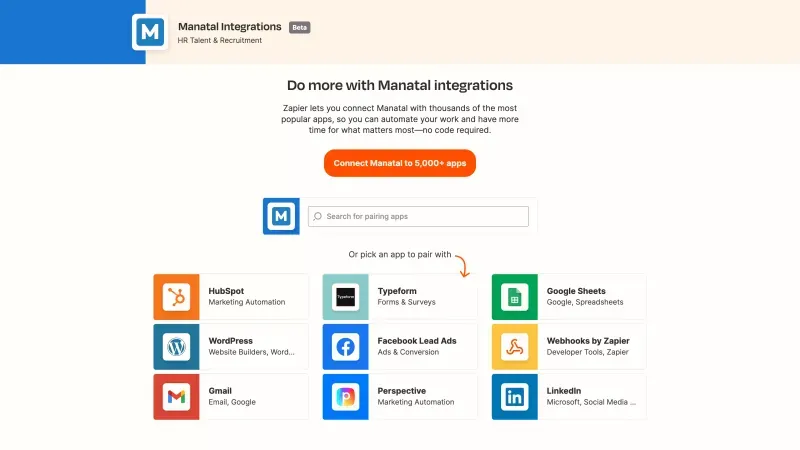
HRIS/HCM System Integration
Manatal effectively supports integration with many popular Human Resources Information Systems (HRIS) and Human Capital Management (HCM) platforms. This capability enables organizations to seamlessly connect recruitment workflows with broader HR functions such as payroll, onboarding, employee data management, and performance management. Manatal offers straightforward, API-based integrations with systems like BambooHR, SAP SuccessFactors, Workday, Oracle, and others, simplifying data synchronization and reducing manual data entry.
Recruiters find significant value in these integrations, as candidate data can be automatically transferred into HRIS/HCM systems once applicants are hired. This streamlined approach improves accuracy, reduces administrative overhead, and ensures consistency across HR databases. Manatal’s integration process is generally straightforward, with clear documentation and support available to guide teams through setup.
However, some users highlight that more complex integrations, particularly with highly customized or legacy HR systems, may require additional support or custom development efforts. Organizations with non-standard HR platforms or very specific integration needs may encounter occasional challenges or require technical assistance during integration setup.
Third-party Tool Integrations (Background Checks, Assessments, etc.)
An essential aspect of modern recruitment is compatibility with specialized third-party recruitment tools, and Manatal delivers robust integration options in this area. The platform readily connects with various external services, including candidate assessment platforms, video interviewing tools, background check providers, and reference check systems. Manatal’s integration ecosystem includes popular services like Checkr for background checks, Criteria Corp and HackerRank for candidate assessments, and platforms like Spark Hire and Zoom for video interviews.
These integrations allow recruiters to initiate assessments, background screenings, or video interviews directly from Manatal, with results automatically stored within candidate profiles. This significantly simplifies candidate evaluation processes, ensures centralized documentation, and accelerates hiring decisions.
Yet, some users indicate a desire for a more extensive selection of pre-built integrations, particularly for industry-specific assessment tools or niche providers. Although Manatal supports most widely-used services, organizations relying heavily on less common third-party tools may need additional customization or manual processes to manage integrations.
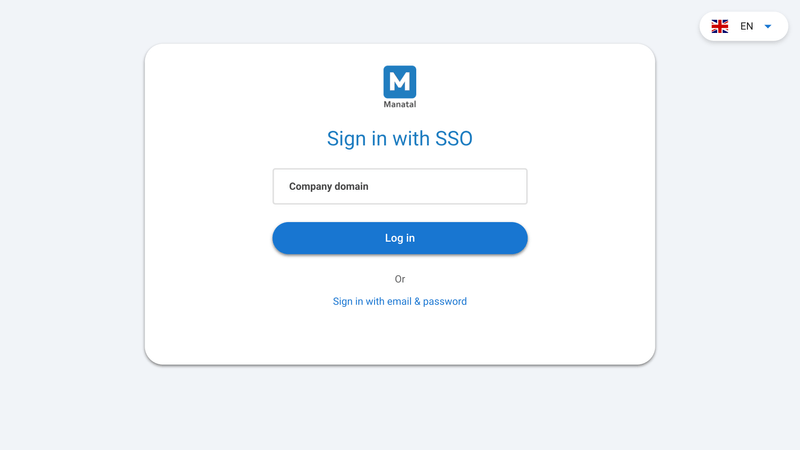
Pros and Cons
To effectively evaluate Manatal’s integration and compatibility features, organizations should consider the following pros and cons outlined in this Manatal review:
Pros of Manatal Integration and Compatibility
- Seamless integration with popular HRIS/HCM systems, facilitating smooth data synchronization and improved HR process efficiency.
- Strong third-party recruitment tool compatibility, including integrations with widely used background checks, assessments, and video interviewing platforms.
- Clear and straightforward integration setup, supported by accessible documentation and responsive customer support.
- Centralized candidate data management, significantly reducing manual entry and administrative errors.
Cons of Manatal Integration and Compatibility
- Potential complexity integrating with legacy or highly customized HR systems, possibly requiring additional technical support or custom development.
- Limited integrations with niche or industry-specific recruitment tools, occasionally necessitating manual workarounds or additional customization.
Conclusion
Overall, Manatal demonstrates strong integration and compatibility capabilities, effectively supporting seamless workflows with major HRIS/HCM platforms and widely adopted recruitment tools. These integrations enhance recruitment productivity, reduce manual administrative tasks, and help maintain accurate and centralized candidate data.
However, organizations utilizing highly customized, legacy, or niche systems might encounter some limitations requiring additional technical support or manual adjustments. Companies with specialized integration requirements should carefully verify Manatal’s compatibility with their existing systems and consider potential customization needs.
Ultimately, Manatal is particularly well-suited for small to medium-sized organizations seeking efficient, user-friendly integration solutions with popular HR and recruitment tools. Larger enterprises or businesses with complex integration needs should assess whether Manatal fully aligns with their technical requirements or if additional integration solutions or custom development might be necessary.
Customization and Scalability
In this detailed Manatal review, we explore the customization and scalability offered by Manatal’s Applicant Tracking System (ATS). Organizations evaluating ATS solutions must consider how easily the platform can adapt to unique recruitment workflows and scale effectively as their hiring needs grow. Below, we analyze Manatal’s capabilities in workflow customization and its ability to manage high-volume hiring.
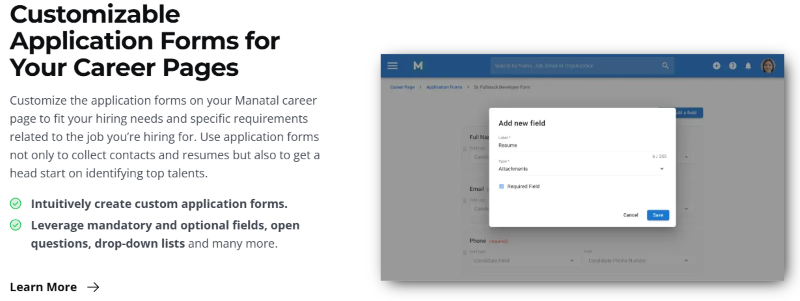
Workflow Customization Options
One of Manatal’s notable strengths is its flexibility in workflow customization. The platform allows recruiters and HR teams to easily adjust recruitment pipelines, candidate stages, and evaluation processes to fit their specific requirements. Users can create and customize candidate stages, define unique evaluation criteria, and adapt the ATS to align closely with internal recruitment strategies.
Recruiters appreciate Manatal’s intuitive drag-and-drop pipeline editor, enabling teams to visually structure recruitment processes tailored specifically to different job roles or departments. Additionally, Manatal’s customizable candidate evaluation templates ensure consistent candidate assessments across recruitment teams, improving transparency and fairness in hiring decisions.
While these customization features significantly enhance workflow efficiency, some users have expressed that Manatal could offer deeper customization for highly specialized workflows. Advanced functionalities such as conditional workflows, complex approval chains, or highly granular automation rules are relatively basic, potentially limiting larger organizations or recruitment agencies with more complex hiring processes.
Ability to Handle High-volume Hiring
When assessing scalability, it’s essential to determine how well an ATS supports high-volume recruitment scenarios. Manatal generally performs well in managing increased candidate volumes, providing recruitment teams with clear candidate pipeline visualization, effective resume screening automation, and streamlined bulk candidate actions. Recruiters can easily track numerous applicants simultaneously, benefiting from the platform’s intuitive interface and straightforward candidate management capabilities.
Manatal’s built-in automation features, such as automated email communication, candidate screening, and scheduling, help maintain efficiency even during busy recruitment periods. These tools significantly reduce manual workload, allowing recruitment teams to maintain productivity without compromising candidate experience.
However, some recruiters have noted that as candidate numbers rise dramatically, certain visual or organizational aspects of Manatal’s pipeline view can become cluttered or less manageable. Teams handling exceptionally high candidate volumes may find it necessary to implement additional segmentation or organizational strategies within the ATS to maintain clear oversight.
Pros and Cons
To effectively evaluate Manatal’s customization and scalability capabilities, recruitment teams should consider these key points outlined in this Manatal review:
Pros of Manatal Customization and Scalability
- Flexible pipeline customization, enabling tailored recruitment processes that align closely with organizational needs.
- User-friendly drag-and-drop interface, simplifying adjustments to recruitment workflows and enhancing usability.
- Effective scalability for moderate to high-volume hiring, supported by automation and streamlined candidate management.
- Consistent evaluation processes, ensured by customizable templates and standardized workflows.
Cons of Manatal Customization and Scalability
- Limited advanced customization features, such as complex conditional workflows or detailed automation rules, potentially restricting larger organizations with specialized recruitment processes.
- Pipeline view can become cluttered, particularly when handling extremely high candidate volumes, requiring additional organizational management.
Conclusion
Overall, Manatal demonstrates strong capabilities in customization and scalability, particularly suitable for small to medium-sized organizations seeking flexibility and growth potential in their recruitment processes. Its intuitive workflow customization, combined with effective candidate volume management, makes Manatal a solid choice for organizations aiming to maintain efficiency during periods of hiring growth.
However, larger enterprises or recruitment agencies with intricate or specialized workflow requirements may encounter certain limitations due to the platform’s relatively basic advanced customization features. Similarly, recruitment teams regularly managing exceptionally high candidate volumes should carefully assess how Manatal’s pipeline management will meet their long-term scalability needs.
Ultimately, Manatal is an excellent choice for organizations prioritizing ease of use, straightforward customization, and effective scaling up to moderate or even high-volume recruitment scenarios. Companies with highly specialized recruitment processes or consistently very large candidate pools should consider carefully if Manatal fully aligns with their unique customization and scalability requirements.
AI and Automation Features
In this comprehensive Manatal review, we evaluate the artificial intelligence (AI) and automation features provided by Manatal’s Applicant Tracking System (ATS). Modern recruitment increasingly relies on AI-driven tools and automation to improve hiring efficiency, candidate quality, and overall productivity. Here, we analyze Manatal’s strengths and limitations regarding AI-powered candidate matching, automated screening, and scheduling functionalities.
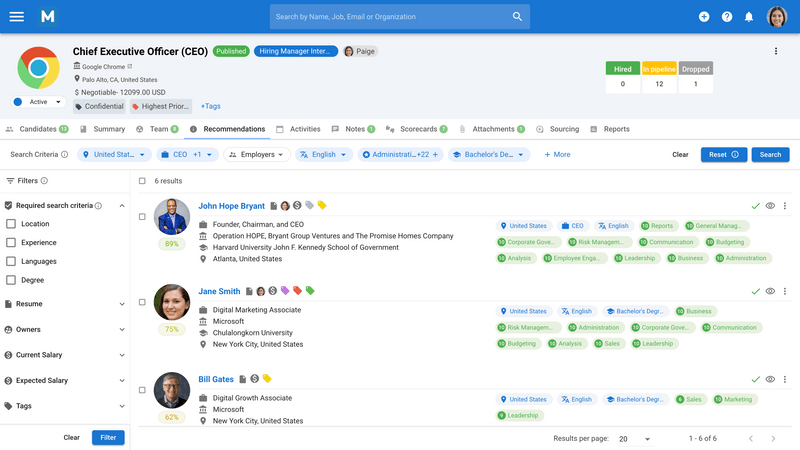
AI-powered Candidate Matching
One of Manatal’s standout features is its AI-powered candidate matching capability, designed to significantly enhance the candidate selection process. Using advanced AI algorithms, Manatal automatically analyzes resumes and job descriptions to identify and rank candidates according to their suitability for specific job roles. Recruiters benefit from rapid, data-driven insights into candidate quality, enabling quicker identification of the most promising applicants.
The AI-matching tool effectively reduces recruiter bias by providing objective assessments based on clearly defined criteria, such as experience, skills, education, and qualifications. Users frequently highlight the accuracy and ease of use of Manatal’s AI-matching engine, reporting substantial reductions in manual resume reviews, increased recruitment speed, and improved hiring outcomes.
However, some recruiters have observed that Manatal’s AI-powered matching occasionally struggles with highly specialized or niche roles, where nuanced skills or specific qualifications may require more manual oversight. Organizations frequently recruiting for very technical or specialized positions may find that manual validation or supplementary screening remains necessary to ensure optimal candidate matches.
Automated Screening and Scheduling
Manatal further enhances recruitment efficiency through robust automated screening and scheduling tools. Recruiters can establish customizable screening criteria to automatically filter incoming applications, quickly identifying candidates who meet essential requirements. This automation significantly accelerates the initial candidate review process, enabling recruiters to prioritize high-potential applicants more effectively.
Additionally, Manatal offers automated interview scheduling functionality, seamlessly integrating with popular calendar tools such as Google Calendar and Outlook. Recruiters can easily send scheduling invitations, allowing candidates to select preferred interview slots from available times, thereby significantly reducing administrative workloads and minimizing scheduling conflicts. Users consistently appreciate this automation for its simplicity, accuracy, and substantial time-saving benefits.
Nevertheless, some users have experienced occasional synchronization delays with calendar integrations, particularly when managing multiple simultaneous interviews or complex scheduling requirements. While these issues are rare, recruitment teams regularly handling large-scale, tightly coordinated interview processes may encounter minor inconveniences.
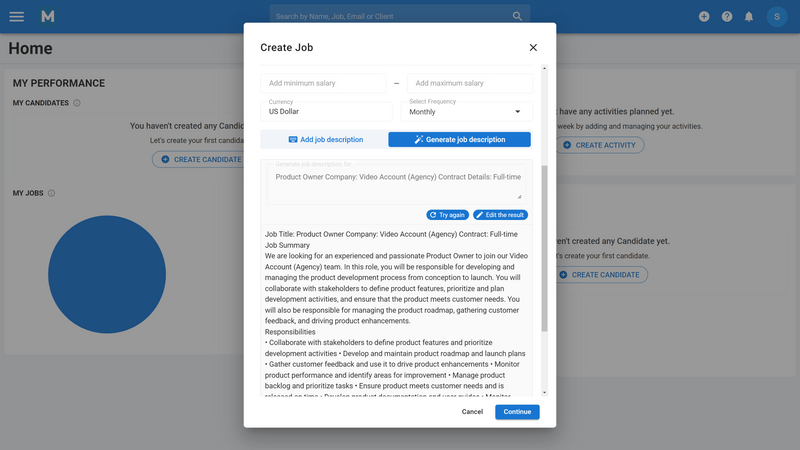
Pros and Cons
To effectively evaluate Manatal’s AI and automation features, consider the following pros and cons identified in this Manatal review:
Pros of Manatal AI and Automation Features
- Effective AI-powered candidate matching, improving recruitment speed and enhancing objective candidate evaluations.
- Customizable automated screening, significantly reducing manual applicant reviews and quickly identifying qualified candidates.
- Efficient automated interview scheduling, simplifying appointment setting and minimizing scheduling conflicts.
- Reduced recruiter bias, thanks to objective AI-driven candidate assessments based on defined job criteria.
Cons of Manatal AI and Automation Features
- Occasional inaccuracies in AI matching for specialized or niche roles, requiring manual oversight in certain cases.
- Minor synchronization delays in automated scheduling, potentially affecting teams with complex or high-volume scheduling needs.
Conclusion
Overall, Manatal delivers highly valuable AI and automation capabilities, significantly streamlining the recruitment process. Its robust candidate matching algorithms, effective automated screening, and intuitive scheduling tools improve recruiter productivity, enhance hiring quality, and reduce time-to-fill rates.
However, organizations frequently recruiting for highly specialized positions or regularly managing complex interview coordination may need to supplement Manatal’s features with manual verification or additional scheduling tools. Companies requiring flawless AI accuracy in specialized hiring contexts or uninterrupted scheduling performance under heavy workloads should carefully evaluate these limitations.
Ultimately, Manatal’s AI and automation features make it particularly well-suited for small to medium-sized organizations or recruitment teams seeking reliable, straightforward automation to improve recruitment efficiency. Organizations with highly specific or technical recruitment requirements should consider carefully whether Manatal fully meets their needs or if supplementary solutions might better enhance their hiring processes.
Candidate Experience
In this thorough Manatal review, we focus specifically on candidate experience—one of the most critical aspects of any Applicant Tracking System (ATS). A positive candidate experience not only enhances an employer’s brand but also helps attract and retain high-quality talent. Here, we closely examine Manatal’s strengths and potential shortcomings regarding application simplicity, communication, and feedback mechanisms.

Application Process Simplicity
One of the highlights identified in our Manatal review is the simplicity and clarity of its application process. Candidates using Manatal-powered career pages benefit from intuitive, straightforward, and user-friendly application forms that significantly reduce frustration and improve completion rates. The platform minimizes unnecessary fields, guiding applicants through clear and concise steps, ensuring the entire application process is quick and effortless.
Manatal also emphasizes mobile optimization, meaning candidates can easily apply from smartphones and tablets without loss of functionality. Given that a large number of candidates now apply using mobile devices, this mobile-first approach ensures maximum accessibility, significantly boosting candidate satisfaction and application completion.
However, some recruiters and candidates note that the application forms could benefit from additional flexibility or customization, particularly for specialized roles that require specific information or detailed pre-screening questions. Organizations with complex or lengthy application requirements might find the standard forms somewhat restrictive, potentially necessitating custom adjustments.
Communication and Feedback Mechanisms
Clear and timely communication is essential to a positive candidate experience, and Manatal performs strongly in this area. The platform provides recruiters with integrated communication tools—including email and SMS—allowing them to promptly update candidates at every recruitment stage. Automated email templates can be personalized to communicate application status updates, interview schedules, and even rejections, ensuring candidates remain informed and engaged throughout the hiring process.
Manatal also facilitates recruiter responsiveness through built-in notification features, enabling hiring teams to promptly follow up with candidates, minimizing the risk of candidates feeling ignored or overlooked. Candidates consistently express appreciation for timely updates, transparent communications, and clear expectations provided by recruiters using Manatal.
Yet, some candidates report occasional delays or inconsistencies, especially in SMS-based updates, indicating there may be minor reliability issues in certain geographic locations. Organizations heavily relying on SMS communications should validate reliability and consider supplementing with email notifications to ensure a seamless candidate experience.
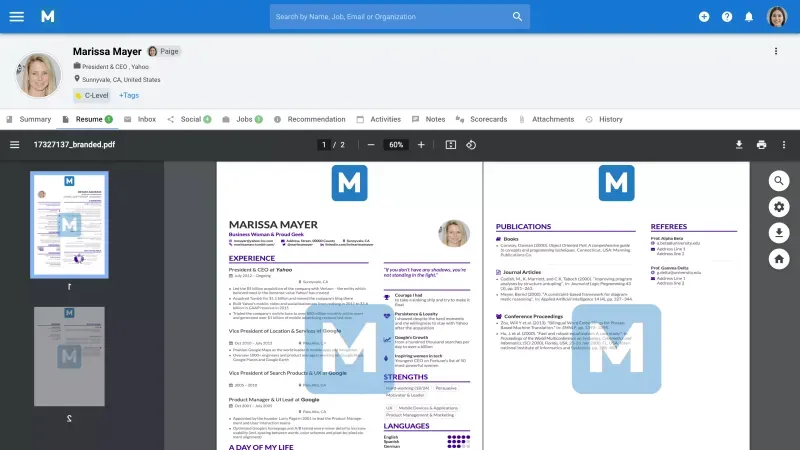
Pros and Cons
To effectively evaluate Manatal’s candidate experience features, organizations should carefully weigh these strengths and potential limitations from our Manatal review:
Pros of Manatal Candidate Experience
- Simple and intuitive application process, significantly enhancing candidate satisfaction and completion rates.
- Strong mobile optimization, ensuring candidates can easily apply across all devices.
- Integrated communication tools, providing timely and transparent updates throughout the recruitment process.
- Personalizable automated notifications, improving candidate engagement and clarity around application statuses.
Cons of Manatal Candidate Experience
- Limited customization options for complex applications, potentially restricting organizations with highly specialized candidate requirements.
- Occasional delays or inconsistencies in SMS notifications, possibly affecting candidate communication in specific regions.
Conclusion
Overall, Manatal excels in delivering a positive candidate experience through its straightforward application processes, excellent mobile optimization, and effective communication features. These capabilities significantly enhance an employer’s brand reputation, encourage candidate engagement, and contribute positively to talent acquisition efforts.
However, organizations with highly specific application requirements or those reliant primarily on SMS-based communications may encounter minor limitations. Companies should carefully evaluate Manatal’s customization and messaging capabilities against their specific needs to ensure seamless candidate experiences.
Ultimately, Manatal is particularly suited for small to medium-sized organizations seeking an intuitive, transparent, and user-friendly candidate journey. Organizations with more complex application requirements or specialized communication needs should assess whether Manatal fully aligns with their candidate experience objectives or if supplemental customization or communication tools might be necessary.
Customer Support and Service
In this detailed Manatal review, we assess the customer support and service provided by Manatal’s Applicant Tracking System (ATS). Effective customer support is essential to ensuring users can maximize the benefits of their ATS investment, address technical issues quickly, and confidently navigate any challenges during setup and daily usage. Below, we evaluate Manatal’s strengths and limitations regarding training and onboarding support, as well as the overall quality of ongoing customer service.
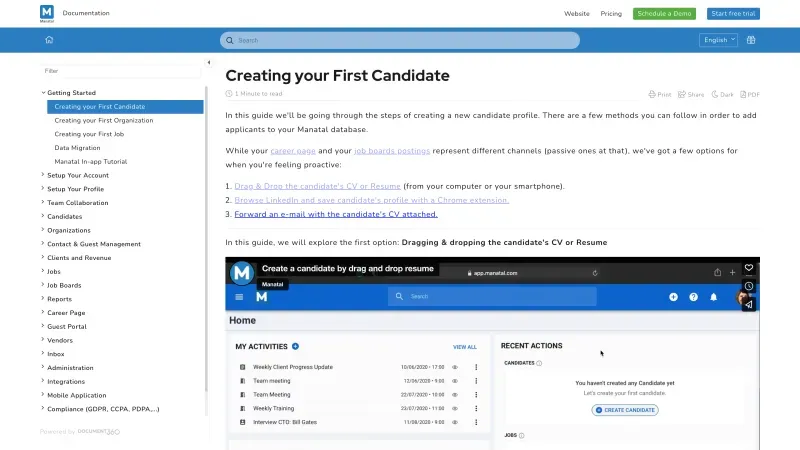
Training and Onboarding Support
Manatal consistently receives positive feedback for its structured training and onboarding support, making it straightforward for recruitment teams to adopt and integrate the platform effectively. Upon subscription, users benefit from personalized onboarding sessions, detailed documentation, helpful video tutorials, and extensive online resources. This comprehensive training approach helps users quickly understand key features, significantly reducing the learning curve and enabling rapid adoption.
Additionally, Manatal’s onboarding team provides proactive guidance to ensure initial setup aligns with organizational needs, including support with integrations, workflow customization, and career page setup. Recruiters regularly highlight Manatal’s onboarding specialists as highly knowledgeable and responsive, helping teams overcome initial hurdles and efficiently transition to using the platform effectively.
However, some users have indicated that organizations with complex integration requirements or highly specialized workflows might require additional or more advanced training beyond Manatal’s standard onboarding support. In these cases, users may benefit from additional personalized training or specialized technical support, potentially requiring supplementary consulting arrangements.
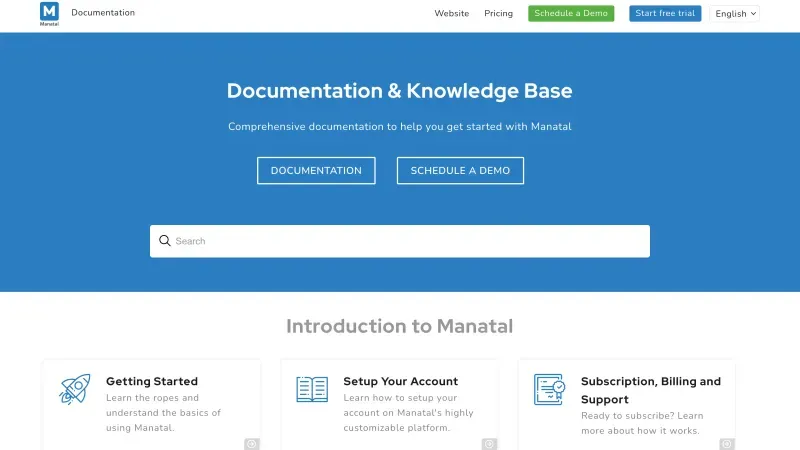
Ongoing Customer Service Quality
Manatal is well-known for providing consistently strong ongoing customer service, which significantly contributes to high user satisfaction rates. Users can easily reach support representatives through multiple channels, including email, live chat, and online ticketing systems. Manatal’s customer service team is typically described as responsive, helpful, and solution-oriented, often resolving issues quickly or providing clear guidance to navigate any platform-related questions.
In addition to responsive live support, Manatal offers a robust help center and comprehensive knowledge base containing detailed documentation, guides, FAQs, and video resources. Recruiters appreciate these readily available self-help resources, often enabling quick resolution of common issues without needing direct support assistance.
Nevertheless, some users mention occasional variability in response times during peak periods or complex technical inquiries, indicating that users requiring immediate support during high-demand times might experience slight delays. Organizations with mission-critical recruitment needs should consider planning for additional lead time or using priority support options if immediate resolution is critical.
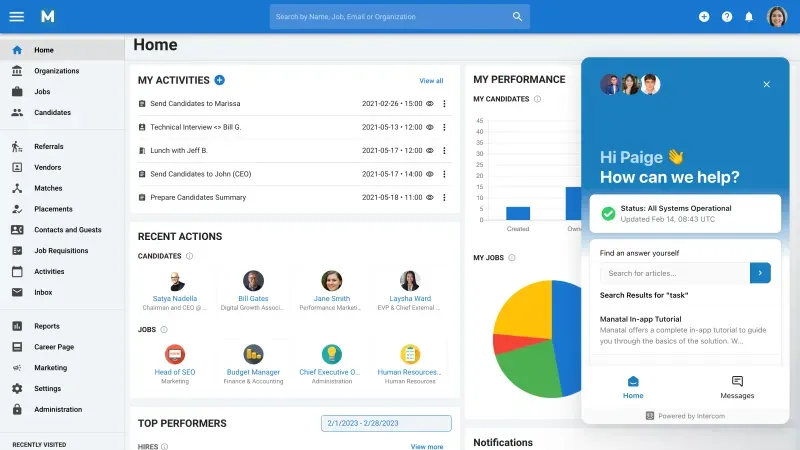
Pros and Cons
To effectively evaluate Manatal’s customer support and service, consider these pros and cons outlined in this Manatal review:
Pros of Manatal Customer Support and Service
- Comprehensive onboarding and training, providing structured resources, video tutorials, and personalized support to enable quick platform adoption.
- Responsive and knowledgeable customer support team, quickly addressing user questions and effectively solving technical issues.
- Extensive online help resources, including detailed guides, FAQs, and documentation, significantly enhancing self-service capabilities.
- User-friendly support channels, enabling easy communication with representatives via email, live chat, and ticketing systems.
Cons of Manatal Customer Support and Service
- Possible additional support required for complex integrations or highly specialized workflows, potentially necessitating supplemental training or consulting services.
- Occasional variability in response times during peak periods or complex issues, potentially leading to slight delays in support resolutions.
Conclusion
Overall, Manatal delivers robust and reliable customer support and service, ensuring recruitment teams can maximize the platform’s benefits and efficiently address technical or operational issues. Its comprehensive onboarding, responsive customer service, and extensive self-service resources help maintain high levels of user satisfaction and platform productivity.
However, organizations with highly specific or complex recruitment requirements might find standard support resources insufficient and could require additional or advanced support services. Companies needing rapid resolutions during periods of peak demand or with mission-critical hiring operations should carefully consider Manatal’s available support options to align with their operational requirements.
Ultimately, Manatal’s customer support and service capabilities make it an excellent fit for small to medium-sized organizations seeking reliable, accessible, and responsive ATS support. Larger or more complex organizations should evaluate whether Manatal fully meets their support expectations or if additional training and priority support services might better address their needs.
Pricing and Cost-effectiveness
In this comprehensive Manatal review, we closely examine the pricing structure and cost-effectiveness of Manatal’s Applicant Tracking System (ATS). Evaluating pricing models and return on investment (ROI) is crucial for organizations to determine if an ATS aligns with their recruitment budget and delivers tangible value. Below, we detail Manatal’s pricing approach, its affordability for various organizational sizes, and how it translates into overall recruitment value.
Pricing Models (Per User, Per Hire, etc.)
Manatal offers a transparent, subscription-based pricing model primarily structured around a flat monthly fee per user, with different pricing tiers based on feature availability and organizational needs. Unlike ATS providers that charge per hire or based on recruitment volume, Manatal’s user-based pricing approach allows organizations to predictably budget their recruitment expenses without worrying about fluctuating hiring activity or additional hidden fees.
The platform typically provides multiple plans, ranging from affordable options suited for smaller teams or startups to premium packages catering to larger organizations requiring advanced integrations, additional storage, enhanced analytics, and dedicated customer support. The flexibility and clarity of Manatal’s pricing make it particularly appealing for small to medium-sized businesses seeking predictable recruitment costs and scalable solutions.
While Manatal’s pricing structure is generally straightforward, some larger enterprises or recruitment agencies managing very large teams might find that per-user pricing adds up significantly as the team size grows. In such scenarios, organizations might need to assess carefully how Manatal’s pricing scales compared to volume-based ATS models offered by some competitors.
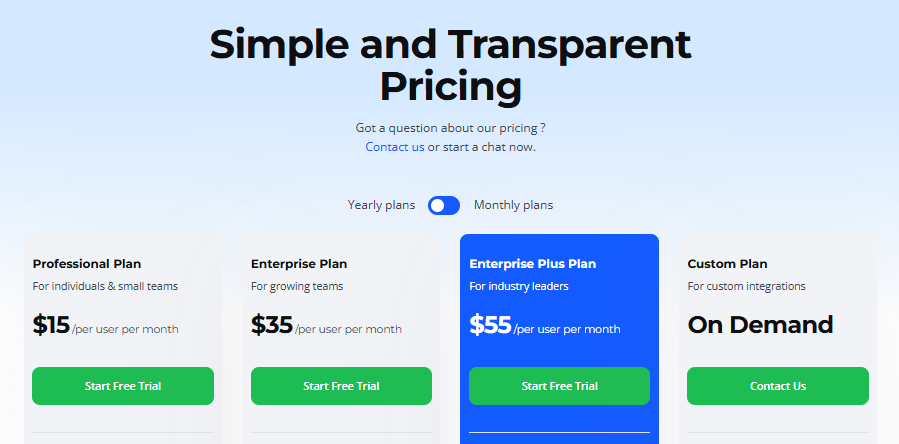
ROI Considerations
Manatal consistently scores highly regarding ROI and overall cost-effectiveness. The system’s competitive pricing combined with robust core features—such as automated candidate screening, AI-powered candidate matching, intuitive recruitment pipeline management, and easy integration—delivers substantial efficiency gains, significantly reducing manual tasks and administrative overhead. These productivity enhancements typically result in faster hiring cycles, improved candidate quality, and tangible financial savings.
Recruitment teams using Manatal frequently report rapid returns on their investment due to reduced recruitment timelines, streamlined candidate evaluations, and minimized reliance on manual processes or external recruitment tools. Moreover, built-in automation and clear recruitment analytics further enhance ROI, enabling recruiters to make strategic hiring decisions with measurable outcomes.
Nevertheless, organizations with highly complex or enterprise-level recruitment requirements may experience diminished returns if they must supplement Manatal’s core offerings with specialized integrations, extensive customizations, or additional advanced functionalities. Such additions can influence overall cost-effectiveness and should be carefully evaluated.
Pros and Cons
To effectively evaluate Manatal’s pricing and cost-effectiveness, consider these key advantages and limitations highlighted in this Manatal review:
Pros of Manatal Pricing and Cost-effectiveness
- Transparent and predictable subscription-based pricing, enabling clear budget planning without hidden or unexpected fees.
- Multiple pricing tiers, suitable for a wide range of organizational sizes and recruitment needs, from small teams to larger enterprises.
- Strong ROI due to significant efficiency improvements, including reduced time-to-hire, streamlined workflows, and automated candidate management processes.
- Competitive pricing relative to feature richness, offering substantial value for money compared to similar ATS solutions.
Cons of Manatal Pricing and Cost-effectiveness
- Potentially high cumulative costs for large recruitment teams, due to per-user subscription pricing structures.
- Possible additional costs for advanced customization or integrations, potentially impacting overall cost-effectiveness for organizations with specialized recruitment needs.
For more information about pricing, se visit Manatal’s website.
Conclusion
Overall, Manatal provides highly attractive and predictable pricing coupled with exceptional cost-effectiveness, making it an appealing choice for small and medium-sized organizations. Its clear subscription-based model, combined with robust automation features and intuitive usability, ensures recruitment teams experience substantial returns on their investment, significantly enhancing hiring efficiency and quality.
However, larger enterprises or recruitment teams with specialized needs should carefully evaluate how Manatal’s per-user pricing scales with their growth and whether additional customization or integration costs could impact overall ROI. Organizations in these scenarios should thoroughly assess total costs relative to potential benefits.
Ultimately, Manatal is particularly well-suited for organizations seeking transparent pricing, scalability, and strong cost-effectiveness in their ATS solution. Companies with extensive recruitment demands or unique customization requirements should carefully review whether Manatal aligns fully with their financial and operational expectations or if alternative pricing structures might better suit their needs.
User Reviews and Testimonials
In this detailed Manatal review, we explore the experiences and feedback shared by recruiters, HR professionals, and candidates who have directly interacted with Manatal’s Applicant Tracking System (ATS). User reviews and testimonials provide valuable real-world insights into the strengths, limitations, and overall satisfaction with the platform. Below, we summarize key user sentiments regarding Manatal’s functionality, ease of use, support quality, and candidate experiences.

Feedback from Recruiters and HR Professionals
Recruiters and HR professionals consistently provide positive feedback about Manatal’s intuitive user interface, efficient candidate management features, and powerful recruitment automation tools. Many users highlight how quickly their teams have been able to adopt and master the platform, greatly appreciating its short learning curve and easy-to-navigate dashboard. Recruiters frequently emphasize that Manatal significantly reduces administrative burdens, enabling them to spend more time on strategic hiring decisions rather than manual tasks.
Additionally, users regularly praise Manatal’s effective integration capabilities, especially its smooth connections with popular job boards, social media channels, and HRIS systems. Recruiters particularly appreciate the convenience and efficiency gained through built-in candidate screening, automated interview scheduling, and easy pipeline visualization.
However, some recruiters have noted minor limitations, particularly around advanced customization or reporting capabilities. Organizations with highly specialized recruitment processes or specific analytics requirements occasionally find that Manatal’s reporting depth or customization flexibility could be expanded further.
Candidate Testimonials
Candidates interacting with Manatal-powered application processes commonly express satisfaction with the simplicity and clarity of applying for positions. User testimonials frequently highlight how straightforward it is to submit applications via mobile devices or desktops, often noting that the experience is faster and less cumbersome than other application processes they have encountered.
Candidates also generally report positive experiences regarding communication and transparency during the recruitment process. Manatal’s automated notifications, clear status updates, and timely recruiter responses have been consistently appreciated by candidates, contributing positively to employer brand perceptions.
However, a few candidate testimonials mention occasional delays or minor inconsistencies in receiving SMS updates or automated communications. While these occurrences appear relatively infrequent, they suggest potential areas for improvement in certain regional contexts.
Pros and Cons from User Reviews
To comprehensively evaluate Manatal based on real user experiences, consider these key strengths and limitations drawn from user testimonials:
Pros Highlighted by Users
- User-friendly interface and ease of adoption, enabling quick and efficient onboarding of recruiters and HR teams.
- Efficient candidate management and automation features, significantly improving recruitment productivity and reducing manual tasks.
- Strong integration capabilities, allowing seamless workflow connections with major HR systems and third-party recruitment tools.
- Positive candidate experience, facilitated by intuitive application forms and effective communication.
Cons Highlighted by Users
- Limited advanced customization and detailed reporting options, potentially constraining organizations with specific analytical or specialized workflow needs.
- Occasional minor delays or inconsistencies in automated candidate communications, specifically SMS-based updates, in certain geographic areas.
Conclusion
Overall, user reviews and testimonials strongly indicate that Manatal is highly regarded by recruiters, HR professionals, and candidates alike. The ATS consistently earns praise for its intuitive usability, efficient candidate management tools, and robust integration options, contributing to high user satisfaction rates and successful recruitment outcomes.
However, user testimonials also highlight areas for improvement, particularly regarding more detailed customization capabilities and occasional inconsistencies in automated communications. Organizations with highly specialized requirements should carefully evaluate these limitations against their operational needs.
Ultimately, based on extensive user feedback, Manatal is particularly suitable for small to medium-sized organizations looking for an intuitive, effective, and well-integrated ATS solution. Companies with advanced analytical or highly specialized recruitment needs may benefit from considering supplementary tools or verifying carefully that Manatal’s feature set fully aligns with their unique expectations.
Alternatives
In this Manatal review, it’s also important to consider alternative applicant tracking systems (ATS) to ensure you select the solution best suited for your organization. While Manatal offers strong overall capabilities, exploring alternative providers helps verify if its features, pricing, and functionalities fully match your specific needs. Here, we briefly review three popular alternatives to Manatal: Workable, SmartRecruiters, and JazzHR.
1. Workable
Workable is a widely-used ATS known for its user-friendly interface, strong candidate sourcing tools, and extensive third-party integrations. Like Manatal, Workable emphasizes ease of use, automated candidate screening, and simplified recruitment marketing. However, Workable offers deeper analytics and more advanced customization options, making it appealing for organizations with more complex hiring workflows.
Workable’s pricing structure is typically based on the number of active job openings rather than per-user subscriptions, which could offer cost advantages for organizations managing larger recruitment teams or fewer simultaneous positions.
Best suited for: Medium-sized organizations and recruitment teams needing advanced analytics and flexible pricing based on job volume.
![]()
![]() Read our full Workable review
Read our full Workable review
2. SmartRecruiters
SmartRecruiters is a robust ATS platform known for its extensive enterprise-level functionality, advanced collaboration tools, and comprehensive candidate experience features. Compared to Manatal, SmartRecruiters provides deeper integrations with enterprise HRIS/HCM systems and more sophisticated recruitment marketing and candidate engagement capabilities.
However, SmartRecruiters’ pricing structure and extensive features generally align with mid-sized to larger enterprises, potentially making it less cost-effective for smaller organizations or startups compared to Manatal’s simpler, user-based pricing.
Best suited for: Medium to large organizations or enterprises with complex hiring processes, requiring sophisticated recruitment marketing, analytics, and integrations.
![]()
![]() Read our full SmartRecruiters review
Read our full SmartRecruiters review
3. JazzHR
JazzHR is another popular ATS solution, particularly recognized for its affordability, simplicity, and effective candidate tracking features. Similar to Manatal, JazzHR emphasizes ease of use, user-friendly customization, and streamlined candidate management. JazzHR’s strength lies in affordability, often making it an attractive option for small businesses and growing teams.
However, JazzHR might fall short in advanced automation and robust AI-driven candidate matching capabilities, areas where Manatal typically performs better. Organizations prioritizing affordability and simplicity over advanced functionalities may find JazzHR a suitable alternative.
Best suited for: Small businesses and startups looking for budget-friendly, straightforward ATS features without extensive AI or automation capabilities.
![]()
![]() Read our full JazzHR review
Read our full JazzHR review
Conclusion
While Manatal provides strong overall performance as highlighted throughout this Manatal review, evaluating alternatives such as Workable, SmartRecruiters, and JazzHR ensures your organization selects the most appropriate ATS aligned with your recruitment goals and budget. Carefully considering these alternative platforms will help you make an informed decision that best matches your specific hiring requirements and strategic objectives.
Conclusion of our Manatal review
In this comprehensive Manatal review, we have closely evaluated Manatal’s strengths and limitations across multiple key areas including user interface and experience, core ATS functionality, applicant management, recruitment marketing, collaboration tools, onboarding integration, reporting and analytics, compliance and data security, integration and compatibility, customization and scalability, AI and automation, candidate experience, customer support, pricing, user testimonials, and potential alternatives.
Overall, Manatal emerges as a robust, user-friendly, and cost-effective Applicant Tracking System (ATS), ideal for small to medium-sized businesses and recruitment teams seeking simplicity, intuitive design, and strong automation features. Its standout strengths include excellent ease-of-use, powerful AI-driven candidate matching, seamless integration with popular recruitment and HR platforms, and strong mobile responsiveness, significantly enhancing recruitment productivity and candidate engagement.
However, organizations with more complex recruitment needs, such as highly specialized workflows, advanced customization requirements, extensive analytics demands, or enterprise-scale hiring volumes, might encounter limitations within Manatal’s feature set. In these cases, alternatives such as Workable, SmartRecruiters, or JazzHR might provide additional capabilities better aligned with their specific needs.
Ultimately, Manatal is particularly well-suited to organizations prioritizing user-friendliness, effective candidate management, transparent pricing, and streamlined recruitment processes. Carefully assessing the advantages and limitations identified in this Manatal review will empower your organization to confidently determine whether Manatal aligns effectively with your recruitment objectives and strategic hiring goals.

